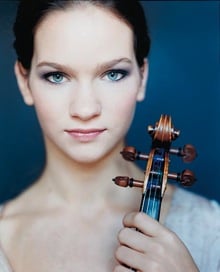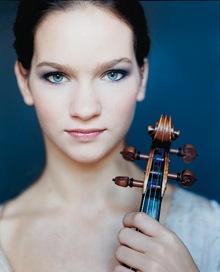
The violin can be the most penetrating of instruments. In the hands of the right violinist it can produce an emotional bleed of sound or convey the most lofty and intellectual of musical ideas. Rarely can it do both in a smartly conceived, forward-looking concert program that makes you think more than a little about musical eras.
These qualities were constantly at play during violinist Hilary Hahn’s resplendent performance at the Mondavi Center for the Arts in Davis on Saturday evening. Hahn appeared with her frequent collaborator and accompanist Valentina Lisitsa, a noteworthy musician in her own right.
The program that Hahn introduced from a stage microphone was a tantalizing one. It offered the West Coast premieres of short works for violin by the likes of Lera Auerbach, Paul Moravec, Einojuhani Rautavaara, and a host of others. But this was a concert program that offered a healthy dose of Bach, Beethoven, and Brahms, too.
Related Articles
Hilary Hahn Artist Profile Page
Bio, Fun Facts and Video
Hilary Hahn: Jumping Into Commissions and the Internet
October 17, 2011
The latter composers were not balkanized on the first half of the program; rather, Hahn commingled old and new throughout the concert. Doing so cast each work in a unique light. Musical timelines became irrelevant. And yet the notion of a piece of music being forever hamstring, for better or worse, to a musical era stayed salient.
The smartly laid out program proved a delectable foundation for Hahn’s highly nuanced and powerfully clear violin style. It was playing well-suited to the many demands posited by contemporary composers. At the same time, this more than served Hahn’s aim of connecting with the lifeblood that runs through the established repertoire. Transitioning from one to the other seemed effortless for her and her accompanist.
Hahn’s insightful and heartfelt performances add to her already regal reputation as an astute interpreter of the contemporary violin repertoire.
Hahn began the concert with Bifu, a work offering limpid violin music underpinned by alluring arpeggios on the piano, written by Tokyo-based composer Somei Satoh. The work was the first of 13 pieces from Hahn’s latest project: “27 Pieces: The Hilary Hahn Encores.” These are a set of works she has commissioned and is currently touring. Her insightful and heartfelt performances of these works add to her already regal reputation as an astute interpreter of the contemporary violin repertoire.
With Nico Muhly’s Two Voices the music was delivered warmly, with Hahn’s notes in the high registers creating a prismlike effect when paired with the lower, darker intonations from Lisitsa. The Muhly work provided great contrast with Jennifer Higdon’s galloping Echo Dash, a well-titled work, where Hahn showed off the clarity of her sound when put under the pressure of speed.
Most notable among the new works performed Saturday was Auerbach’s Speak, Memory, a dark and tortured musical work, and a night-swim musical dream by Rautavaara titled Whispering. If ever there was an argument about how the violin can entrance, these works would make an elegant example. Hahn made them both into rich and powerful musical statements in which she captured the full weight of every musical idea.
Sealing the Deal
The burst of new works was counterbalanced with Beethoven’s Sonata for Violin and Piano in A Major. Hahn delivered this work with a moderate pace, the tasty Andante a game of fully seized dynamics and finely shaped notes. Hahn’s onstage relationship with Lisitsa was fully cemented with the sonata. Lisitsa owns a big sound at the keyboard, but it was a sound she ramped down delicately for finer musical moments throughout the evening. These two musicians are now inhabiting a locked-in zone when they perform, and it was a stunning example of how the right piano accompanist can seal the musical deal.
The Ives sounded thoroughly modern in Hahn’s hands.
The second half of the recital was marked deeply by Hahn’s performance of Bach’s Sonata No. 1 for Unaccompanied Violin in G Minor. This is a work that Hahn first played at age 8, and the familiarity showed. Her performance of it was a stunning display of musicality. Hahn performed each of the three movements with an earthy tone. The Adagio was a daring bleed of notes, and the Fugue revealed Hahn’s fondness for making her violin sound gritty and granular.
If the recital had ended at this juncture it would have been well worth any entrance fee, but a buoyant performance of Brahms’ Sonata for Violin and Piano in C Major followed, as did more new works. Many of these were filled with sadness and longing, like Max Richter’s Mercy, which Hahn was careful to perform without verging into bathos.
The icing on the cake of the evening was Hahn and Lisitsa’s returning to the stage for an encore, Charles Ives’ Largo, from 1901. Curiously, this work hovered in its own lonely time-space between the Bach and the new works. Hahn played the short work with a sense for how the violin can sing, while Lisitsa added a dash of daring to some of the clusterlike notes on the piano. The Ives sounded thoroughly modern in Hahn’s hands. Hearing her performing the Ives raises two notions: that Ives’ music deserves a much wider outing, and that Hahn’s recently released Deutsche Grammophon recording, Charles Ives: Four Sonatas, may be well worth a listen.

